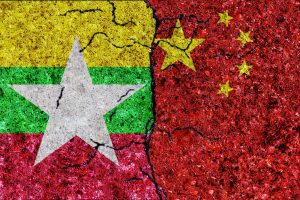The deputy leader of Myanmar’s military junta has embarked on an official visit to China, as clashes with ethnic armed groups intensify in Shan State following the apparent collapse of a China-brokered ceasefire.
Vice-Senior Gen. Soe Win touched down on Saturday in Qingdao, in Shandong province, AFP reported, quoting a statement from the junta’s information office. According to the statement, he will attend a Green Development Forum hosted by the Shanghai Cooperation Organization on July 8 and 9.
Junta chief Senior Gen. Min Aung Hlaing has not visited China since the military coup of February 2021, making Soe Win the senior-most official from the military State Administration Council (SAC) to visit the country.
The visit follows the collapse of a China-brokered ceasefire and the resumption of fighting in northern Shan State, where the forces of the Three Brotherhood Alliance of ethnic armed groups have gone on the offensive against the SAC since the last week of June.
Last week, the Ta’ang National Liberation Army (TNLA), and the Myanmar National Democratic Alliance Army (MNDAA), two members of the Alliance, both launched offensives in the vicinity of Lashio, the largest city in northern Shan State. The TNLA has accused the SAC forces of breaking the ceasefire, which was signed in Kunming in January.
The TNLA said yesterday that it and its anti-regime allies were in the process of “surrounding” the city, which is a crucial junta toehold in the region, housing the Myanmar military’s North Eastern Regional Command. This came amid reports of “intense clashes” in the outskirts of the city on Saturday, after the Alliance and its allies captured the headquarters of a frontline military battalion defending its approaches.
Also yesterday, the TNLA announced that it had seized control of the Gokteik Viaduct, a colonial-era railway bridge that spans a massive ravine around 70 kilometers northeast of Pyin Oo Lwin, the location of the Myanmar military’s Defense Forces Academy. Fighting continued to rage in a number of townships straddling the railway and highway between Pyin Oo Lwin and Lashio.
The MNDAA and TNLA attacks appear to mark a resumption of Operation 1027, a strikingly successful offensive that the Three Brotherhood Alliance launched late last year. By the time the ceasefire was brokered in January, the Alliance had seized a large swathe of territory along Shan State’s border with China, including control of several important border crossings.
Whether coincidentally or otherwise, this resumption of fighting has coincided with a burst of diplomatic exchanges between the SAC and China. Former President Thein Sein paid a visit to Beijing on June 29, where he met with Chinese Foreign Minister Wang Yi. China’s special envoy to Myanmar Deng Xijun also met with junta Foreign Minister Than Swe in Naypyidaw on June 19, just before the resumption of fighting in northern Shan State.
These meetings have prompted conjecture that the military administration is reaching out to Beijing in a bid to bring its leverage to bear and halt the Alliance’s offensive. It would be unlikely if Soe Win did not bear a similar message to China this weekend, given his prominent position in the regime and tenuous position facing the SAC in northern Shan State.
Though China could be pivotal to the course of the conflict in Shan State its position on the latest offensives remains unclear. The first phase of Operation 1027 was widely believed to have proceeded with passive Chinese acceptance, due to Beijing’s frustration at the junta’s failure to root out the industrial-scale online scamming operations in Kokang, a territory along the Chinese border then controlled by a junta-aligned Border Guard Force that the MNDAA reconquered during Operation 1027.
In an article last week, I quoted a Myanmar analyst as saying that China might again stand aside, frustrated by the SAC for breaking the ceasefire pact. However, there are some signs that Beijing may be less sanguine about the current offensive. On July 4, local media reported that the Chinese authorities had cut power to Laukkai, the capital of the MNDAA-controlled Kokang Self-Administered Zone in northern Shan, following the group’s offensive on Lashio, which one observer said “may indicate that China does not accept the MNDAA’s breach of the ceasefire.”
While China has considerable leverage over the MNDAA and TNLA, it remains to be seen whether it would be enough to halt the growing momentum of the new offensives – if that indeed is Beijing’s intention.

































